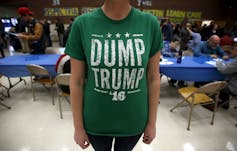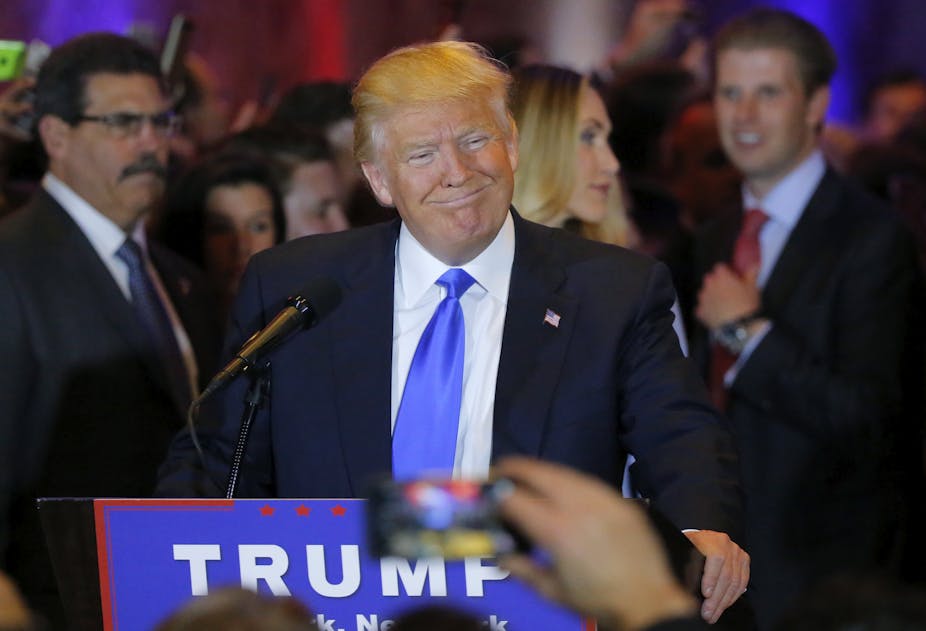Donald Trump is the Republican establishment’s worst nightmare, but the GOP leadership can’t find a way to stop him.
Tuesday night provided the latest example. The New York billionaire swept all five of the GOP primaries, winning Pennsylvania, Maryland, Connecticut, Delaware and Rhode Island.
Trump’s victory margins were particularly telling. Until lately, he had only managed to win primaries with a plurality of the vote. For example, he won New Hampshire with 35 percent of the vote, South Carolina with 32 percent, Michigan with 36 percent, and Illinois with 38 percent. Even in Florida, Trump’s home away from home, he was held under 50 percent.
Trump’s inability to win a majority of the vote in the early primaries gave the Republican establishment hope. The idea was that if they could find an anti-Trump candidate to coalesce around, they could block his path to the nomination.
A majority candidate

But Trump is no longer merely a plurality candidate. The first breakthrough came in New York on April 19 when he carried 60 percent of the vote, a smashing victory. New York opened the floodgates. On Tuesday night Trump won large majorities in each of the five GOP primaries. He carried Connecticut with about 58 percent of the vote, Delaware with 61 percent, Maryland with 55, Pennsylvania with 57, and Rhode Island with 64.
Trump’s victory margins exposed the weakness of the non-aggression pact Ted Cruz and John Kasich struck on Sunday. In a much ballyhooed agreement, the two Republicans pledged to work together to stop Trump’s momentum in the final primaries.
But Tuesday night’s results suggest that their efforts are too little, too late. A one-on-one matchup won’t help Cruz or Kasich if Trump keeps winning primaries with more than 50 percent of the vote.
Making matters worse for the “Stop Trump” movement, the upcoming primaries do not look promising for Cruz or Kasich. The latest polls show Trump with a 5-point lead or better in Indiana, which holds its primary on May 3, and the polls suggest he has a 25-point lead in both California and New Jersey, which hold their primaries on June 7.
Consequently, for all the talk of a brokered GOP convention in July, the likelihood is growing that Trump will secure the 1,237 delegates he needs to clinch the nomination.
Not the GOP of old
So why hasn’t the “Stop Trump” movement worked?
The reason is because the Republican party is changing before our eyes. In the modern era, Republicans have traditionally embraced three core ideas: social conservatism, libertarian economic policies, and the aggressive use of American military power abroad.
But none of those ideas have resonated with Republican voters this year.
Start with social conservatism. If Republicans had wanted to promote a conservative social agenda in 2016, Ted Cruz was the perfect candidate. The son of a minister, Cruz has made opposition to abortion and same sex marriage central themes of his campaign.
But even in the archconservative Deep South, Republican voters have largely rejected Cruz. Instead they have chosen to support a thrice-married, foul-mouthed, reality TV star who does not seem to attend church regularly.
Likewise, small government conservatism has also fallen by the wayside in 2016.
If Republicans wanted a budget balancing, tax cutting, free market conservative, John Kasich would be the ideal choice. A successful GOP governor of the swing state of Ohio, Kasich spent 18 years in Congress, where he served as chair of the House Budget Committee and developed a well-earned reputation as a budget hawk.
Yet, Kasich is running a distant third in the GOP primaries. He’s losing to a New York billionaire who wants to massively increase government spending on everything from border security to infrastructure projects.
But perhaps most striking of all is Trump’s apostasy in foreign affairs.
The contrast between Trump and past Republican presidents is stark. Reagan bombed Libya, invaded Grenada and told Mikhail Gorbachev to tear down the Berlin Wall. George H.W. Bush invaded Panama and expelled Saddam Hussein from Kuwait. And George W. Bush invaded Afghanistan and Iraq.
Trump, in contrast, wants to leave the Middle East to Vladimir Putin’s Russia and openly questions the value of NATO.
Trump’s GOP
In short, Trump is creating a new Republican party, one that is deeply pessimistic about America’s prospects at home and abroad.
Under Ronald Reagan in the 1980s, the old Republican party supported free trade policies, NATO’s containment of the Soviet Union and amnesty for 3 million unauthorized immigrants.
In contrast, Donald Trump’s GOP is a party that advocates trade protectionism, isolationism, and severe restrictions on immigration. In an implicit rejection of Reagan’s “morning in America” optimism, Trump warns that “the American dream is dead” and “we’re becoming a Third World country.” For all his bluster about making America great again, Trump’s GOP is a party that has lost its faith in America.
If the polls are any guide, Trump’s approach is not likely to work in November. He began the primaries with the highest unfavorability ratings of any candidate in history and his standing with the general public has only gotten worse with time. Today 70 percent of women and 67 percent of Americans overall view him unfavorably.
But a critical mass of Republicans back him and he’s riding that support to the GOP nomination. Therefore, no matter what happens in November, Trump will leave a deep and lasting impression on the Republican party long after the 2016 election is over.

